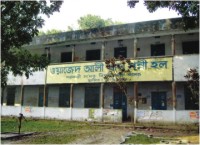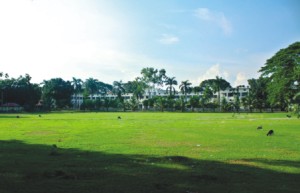| Spotlight


Tanzina Rahman

BACK in the olden days, when this country was under the British rule, English was imposed as the official language on the people. The Muslim society protested about the decision and anything that was associated with English was shunned. As a result, the Muslims lost every opportunity to compete with the modern world and attaining higher education remained nothing but a dream.
Though being uneducated was considered a stigma in the Muslim society, there came a gallant leader with integrated personality, a renowned Zamindar to establish higher education institutions that would extend educational opportunities to poor people, particularly the Muslims.
Wajid Ali Khan Panni (Chand Mia), also known as the hero of Muslim Renaissance of Bengal, visualised the impossible and made it happen. Born on the 25th of April, 1871 as son of Hafez Mahmud Ali Khan Panni, the Zamindar of Karatia, Chand Mia received primary education at home by a tutor. Even though he was born into an immensely wealthy Zamindar family, he devoted his life to helping people of all races and creeds and has come to be recognised as one of the most prominent social reformers and benevolent Zamindars of all times.
 Chand Mia founded the three great institutions in the heart of Karatia, Tangail. Among which was Sadat College, the first Muslim college of the country. In 1926, he established this institution and named it after his grandfather Sadat Ali Khan Panni. He also founded a school Hafez Mahmud Ali Institution in 1900 in the name of his father Hafez Mahmud Ali Khan and a Madrasa in memory of his wife Rokeya entitled as Rokeya High Madrasa. There were some handful of schools established at that time and the Muslims were not able to afford the high tuition fee. Keeping this in mind, Chand Mia decided to set the education free for the poor students. Later on, he further expanded his renaissance zeal by concentrating on the promotion of social, educational, and healthcare activities by donating his entire estate. Chand Mia founded the three great institutions in the heart of Karatia, Tangail. Among which was Sadat College, the first Muslim college of the country. In 1926, he established this institution and named it after his grandfather Sadat Ali Khan Panni. He also founded a school Hafez Mahmud Ali Institution in 1900 in the name of his father Hafez Mahmud Ali Khan and a Madrasa in memory of his wife Rokeya entitled as Rokeya High Madrasa. There were some handful of schools established at that time and the Muslims were not able to afford the high tuition fee. Keeping this in mind, Chand Mia decided to set the education free for the poor students. Later on, he further expanded his renaissance zeal by concentrating on the promotion of social, educational, and healthcare activities by donating his entire estate.
The immediate result of patronizing these institutions to focus on intellectual awareness helped the Muslim nation to rise once again. Thus they were able to secure respectful positions in the employment sectors.
The founding member and the first principal of Sadat College was the renowned educationalist Principal Ibrahim Khan. He was the first chief executive of the college who gave up his prestigious position and teaching in University of Dhaka in order to build the academic sector in Karatia and increase literacy among the poor Muslims. He worked in the college till 1947.
The college was upgraded as a degree college in 1938 and was renamed as Saadat University College. Following this great expansion, Honours course was commenced in 1966 and the Masters course was commenced in 1974. The government of Bangladesh announced the Saadat College as a national university college on July 7, 1979.
 Today more than fifteen thousand students, both male and female are studying in Sadat University College. It offers Honours programme in 16 subjects and Masters programme in 10 subjects. The univesity consists of four main faculties including-- Faculty of Arts (B.A) which comprises of Department of English, Department of Bangla, Department of History, Department of Philosophy, Department of Islamic history and culture, Department of Islamic study; Faculty of Science (B.SC) which comprises of Department of Physics, Department of Chemistry, Department of Math, Department of Zoology, Department of Botany Faculty of Social Science (B.S.S), Department of Economics, Department of Social welfare, Department of Political science; Faculty of Commerce (B.B.S) which comprises of Department of Accounting and Department of Management. Today more than fifteen thousand students, both male and female are studying in Sadat University College. It offers Honours programme in 16 subjects and Masters programme in 10 subjects. The univesity consists of four main faculties including-- Faculty of Arts (B.A) which comprises of Department of English, Department of Bangla, Department of History, Department of Philosophy, Department of Islamic history and culture, Department of Islamic study; Faculty of Science (B.SC) which comprises of Department of Physics, Department of Chemistry, Department of Math, Department of Zoology, Department of Botany Faculty of Social Science (B.S.S), Department of Economics, Department of Social welfare, Department of Political science; Faculty of Commerce (B.B.S) which comprises of Department of Accounting and Department of Management.
The university is also well recognised as a postgraduate college and has become the basis to cultivate knowledge and the hub where thousands of students from different districts come to study.
 On the other hand, Rokeya High Madrasa, the institution that was dedicated for the Muslim girls, stands as the example of one of the very first feminist revolutions in Bengal that changed the perception towards women in society and developed a strong platform for the female education. On the other hand, Rokeya High Madrasa, the institution that was dedicated for the Muslim girls, stands as the example of one of the very first feminist revolutions in Bengal that changed the perception towards women in society and developed a strong platform for the female education.
The Rokeya Hall, which was built in 1906 for residential usage, has been given to a school-- Light House.
Although these historic institutions needs to be renovated from time to time, according to Wajid Ali Khan Panni, former M.P. And Deputy Foreign Minister, who now carries on the family legacy and assists with every possible need to further improve the institutions, said that the institutions in Karatia are providing modern education as per need of the time. In fact, currently there are two computer laboratories to assist the students with their co-curriculum work and develop their technological skills. While he is not directly involved with the institutions, he does visit Karatia regularly to ensure that it is giving the best quality of education that his forefathers dreamt of.
What is inspiring about the founder of these educational institutions is that Chand Mia has not placed his name in any of these institutions to promote himself. His philanthropic work for the society lies in the heart of many who are grateful to have attained education in Karatia. These institutions played a major role in eradicating illiteracy among the Muslims in the region.
|

